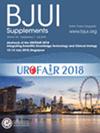Long-term urinary outcomes in classic bladder exstrophy: results of an extensive follow-up
Abstract
Objectives
To evaluate long-term outcomes and predictive factors of urinary continence (UC) and fecal continence (FC) after surgery for classic bladder exstrophy (CBE) using validated questionnaires.
Patients and Methods
This study is part of the QUALEXSTRO study, a retrospective, observational, single-centre cohort study assessing through questionnaires UC, FC, sexuality, fertility, and quality of life in patients treated for CBE, who were aged of at least 15 years at evaluation. Herein, UC and FC were assessed using the International Consultation on Incontinence Questionnaire-Urinary Incontinence Short Form (ICIQ-UI SF) and the Fecal Incontinence Quality of Life Scale (FIQL), respectively.
Results
Of the 63 eligible patients, 42 patients responded to the study (response rate 66.7%). Most patients were treated using the modern staged repair exstrophy technique (88.1%) with pelvic osteotomy (95.2%). A total of 69% of patients underwent continent urinary diversion, 61.9% underwent augmentation enterocystoplasty (AEC), and 7.1% underwent bladder neck closure. Additional endourological procedures were performed in 45.2% of patients. The median (interquartile range [IQR]) age and follow-up were 26 (18–35) years and 22 (17–32) years, respectively. Regarding the voiding mode, 21.4% of patients were able to void spontaneously per urethra without intermittent catheterisation, while 76.2% performed clean intermittent self-catheterisation (CISC). All patients who underwent AEC performed intermittent catheterisation. The median (IQR) ICIQ-UI SF score was 8 (0–13) and was significantly better in women (P = 0.002). A total of 13 patients (30.9%) were continent (ICIQ-UI SF score = 0). Of these, three were able to void spontaneously per urethra, 10 used CISC, and seven underwent AEC. Most patients (66.7%) did not respond to the FIQL questionnaire since they had no concerns regarding FC.
Conclusions
Achieving UC depends on both initial and subsequent surgeries, with few patients able to void per urethra during adulthood. Women have better urinary outcomes than men.


 求助内容:
求助内容: 应助结果提醒方式:
应助结果提醒方式:


